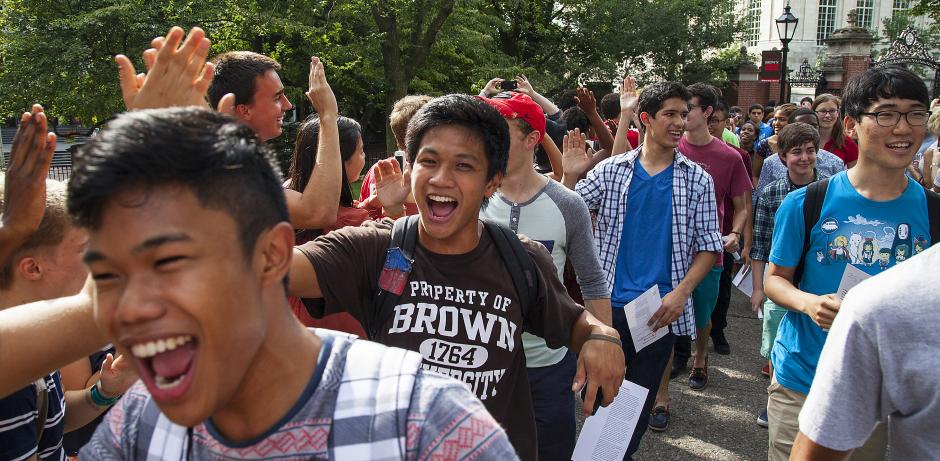PROVIDENCE, R.I. [Brown University] — Brown University President Christina Paxson officially opened the University’s 251st academic year during Opening Convocation celebrations, Tuesday, Sept. 2, 2014, at 4 p.m. on the College Green. Provost Vicki Leigh Colvin delivered the opening address titled “Fresh Eyes.”
The ceremony began with the traditional procession of incoming students through the Van Wickle Gates onto the College Green. This year, Brown welcomed 1,562 first-year students, 678 graduate students, 125 medical students, 51 transfer students, and four students enrolled in the Resumed Undergraduate Education program. (Opening Convocation was livestreamed and is available online as are the texts of President Paxson’s welcoming remarks and Provost Colvin’s keynote address.)
Vicki Leigh Colvin
A graduate of Stanford University (chemistry and physics, 1988), Colvin earned her doctorate at the University of California–Berkeley (chemistry, 1994). After two years at Bell Laboratories as a postdoctoral researcher and then as a member of the technical staff, she began her academic career at Rice in 1996 as an assistant professor in the Department of Chemistry.
In the year after her arrival at Rice, Colvin received a CAREER Award from the National Science Foundation, the NSF’s most prestigious award for junior faculty, intended to help some of the nation’s most promising young scientists establish their research and teaching careers. She was also honored for her undergraduate teaching, winning Rice's Phi Beta Kappa teaching award for junior faculty and the national Dreyfus Teacher-Scholar Award three years later.
In her research career, Colvin has authored or co-authored more than 140 journal articles or book chapters. Her work has been honored with fellowships (Sloan fellow, AAAS fellow, fellow of the American Institute for Medical and Biological Engineering) and recognized by consumer publications (“Best and Brightest” honoree by Esquire in 2008, “Top 20 Young Scientists to Watch” by Discover magazine in 2000). For three and a half years, she served as co-director of the Richard E. Smalley Institute for Nanoscale Science and Technology at Rice, and for more than a decade, starting in 2001, she directed the Center for Biological and Environmental Nanotechnology, one of NSF’s first Nanoscience and Engineering Centers.
More recently, Colvin has served on the NSF’s Advisory Committee for International Science and Engineering, chaired the National Institutes of Health’s Nanotechnology Study Section, been a member of the Intelligence Science Board, and served on editorial boards and advisory councils for a number of journals and professional organizations. She has also been an advocate for public communication about science and research, including a presentation for the Sackler Colloquium on the Science of Science Communication at the National Academy of Sciences in Washington, D.C.
Colvin began her duties as Brown’s 12th provost on July 1, 2014.
The Class of 2018
A total of 30,431 students applied for admission to Brown’s undergraduate Class of 2018. The University admitted 2,667 students (8.8%), yielding a matriculating class of 1,562:
- Gender: 764 men (49%) and 798 women (51%);
- Diversity: 40 percent of the Class of 2018 are students of color;
- First-generation: 17 percent of students are first-generation college students;
- Academic interests: Engineering, biology, computer science, biochemistry, molecular biology, and English are among the most popular intended areas of concentration;
- Geographic area: The Class of 2018 comes from 47 U.S. states and 73 countries. Fifteen percent of students are international. The top foreign countries represented are China, India, Canada, United Kingdom and Korea.
- Financial aid: 45 percent of the Class of 2018 will receive need-based scholarship or grant aid. Sixty-four percent of those students will have no loans in their financial aid awards, and 36 percent will have no expected parental contribution from income.
The Graduate School
A total of 9,416 students applied to begin master’s and doctoral programs at Brown. The University admitted 1,716 (18%), yielding a matriculating class of 678. Selectivity for Ph.D. programs was 12 percent. Thirty-four percent of incoming graduate students are international. The top foreign countries represented are China, Korea, India, and Canada.
The Warren Alpert Medical School
One-hundred and twenty-five new medical students will begin their studies at Brown. The Warren Alpert Medical School received 4,874 applications for its Class of 2018, the largest pool in the school’s history. The medical student body has been increasing in recent years, drawing students from several admission routes. Forty-four of the new students are entering the medical school portion of Brown’s eight-year Program in Liberal Medical Education, which they entered as high school graduates. Three were admitted through Brown’s Early Identification Program in Medicine, and six were admitted through pre-medical post-baccalaureate programs. Overall, matriculating medical students range in age from 20 to 30. They have earned degrees in more than 30 different majors, from anthropology to cognitive neuroscience engineering to theater arts. Ten students have advanced degrees, with graduate work in education, biomedical engineering, computer science, sociology, narrative medicine, and biological/life sciences.

